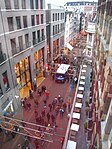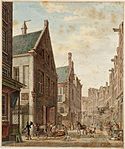Amsterdam Dungeon
Buildings and structures in AmsterdamMerlin Entertainments GroupTourist attractions in Amsterdam

The Amsterdam Dungeon, in the city of Amsterdam, Netherlands, follows a similar format to the London Dungeon, York Dungeon, Berlin Dungeon and Hamburg Dungeon which are owned and operated by UK-based Merlin Entertainments and attempts to show history through an interactive adventure. Live actors, a ride, shows and special effects simulate historical dark and bleak times, it was first opened in September 2005.
Excerpt from the Wikipedia article Amsterdam Dungeon (License: CC BY-SA 3.0, Authors, Images).Amsterdam Dungeon
Enge Kapelsteeg, Amsterdam Centrum
Geographical coordinates (GPS) Address Nearby Places Show on map
Geographical coordinates (GPS)
| Latitude | Longitude |
|---|---|
| N 52.37 ° | E 4.892 ° |
Address
Enge Kapelsteeg 2
1012 NT Amsterdam, Centrum
North Holland, Netherlands
Open on Google Maps











